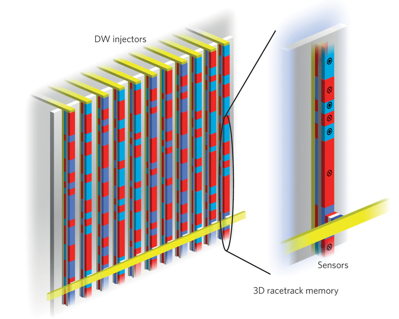Memory on Racetrackp
Racetrack memory stores digital data in magnetic domain walls of nanowires.
By Francis Pelletier | March 12, 2015 at 2:47 pmNature Nanotechnology has published an article written by Stuart Parkin and See-Hun Yang, IBM, Almaden Research Center, San Jose, CA. Parkin is also at the Max Planck Institute for Microstructure Physics, Halle, Germany.
Racetrack memory stores digital data in the magnetic domain walls of nanowires. This technology promises to yield information storage devices with high reliability, performance and capacity.
3D technology: Racetrack Memory 4.0. Red and blue regions
represent areas that are oppositely magnetized.
Abstract: “Magnetic hard disk drives have been the prime repository of digital data for more than half a century. Just over ten years ago the storage capacity of all the world’s magnetic disk drives surpassed that of analogue data storage devices, thereby making possible the world of digital data. The technology of the magnetic hard disk drive is two-dimensional (2D); digital data are stored as the magnetization direction of tiny regions on a magnetic thin film that covers the surface of a glass disk. These regions are read and written by a mechanical device – the recording head – that sits just a few nanometres above the surface of the disk. Over the past 50 years, the area of one magnetic bit has decreased in size by about around nine orders of magnitude; it is now so tiny that the technologies needed to find, read and write bits are reaching fundamental limits that are difficult or too expensive to overcome. Today, improvements in the storage capacity of the magnetic disk have slowed to a crawl. A number of alternatives to the magnetic disk drive have been suggested. Among them, racetrack memory proposed ten years ago – seems close to realization, given recent advances in fundamental physics and materials science related to this technology.“















 Subscribe to our free daily newsletter
Subscribe to our free daily newsletter

